Recognizing brown birds, often referred to as LBJs (Little Brown Jobs), can pose a challenge due to their relatively indistinct features compared to more brightly colored avian species.
However, don’t despair! This article will guide you through the process of identifying sparrows, wrens, or any other brown feathered visitors you might encounter. Plus, it will clue you in on the types of brown birds you might spot in Missouri throughout the year.
This handy guide aims to assist you in identifying brown birds, whether they are frequenting your backyard or spotted out in the countryside. The list provided is arranged from the most common to the least common, as reported by bird enthusiasts through their checklists on ebird for Missouri.
Breakdown of Brown Birds in Missouri by Season
Year-round Brown Birds in Missouri: Northern Cardinal, Mourning Dove, American Robin, American Goldfinch, Carolina Wren, House Sparrow, House Finch, Northern Flicker, Song Sparrow, Cedar Waxwing.
Summer Brown Birds in Missouri: Brown-headed Cowbird, Eastern Phoebe, Chipping Sparrow, Brown Thrasher, Field Sparrow, Common Yellowthroat, Eastern Towhee, Great Crested Flycatcher, House Wren, Rose-breasted Grosbeak, Louisiana Waterthrush, Wood Thrush, Bewick’s Wren.
Winter Brown Birds in Missouri: White-throated Sparrow, White-crowned Sparrow, Swamp Sparrow, Purple Finch, American Tree Sparrow, Savannah Sparrow, Brown Creeper, Hermit Thrush, Winter Wren, Spotted Towhee.
Brown Birds during migration season in Missouri: Swainson’s Thrush, Pine Siskin, Northern Waterthrush, Marsh Wren.
38 Brown Birds In Missouri
1. Northern Cardinal – Female
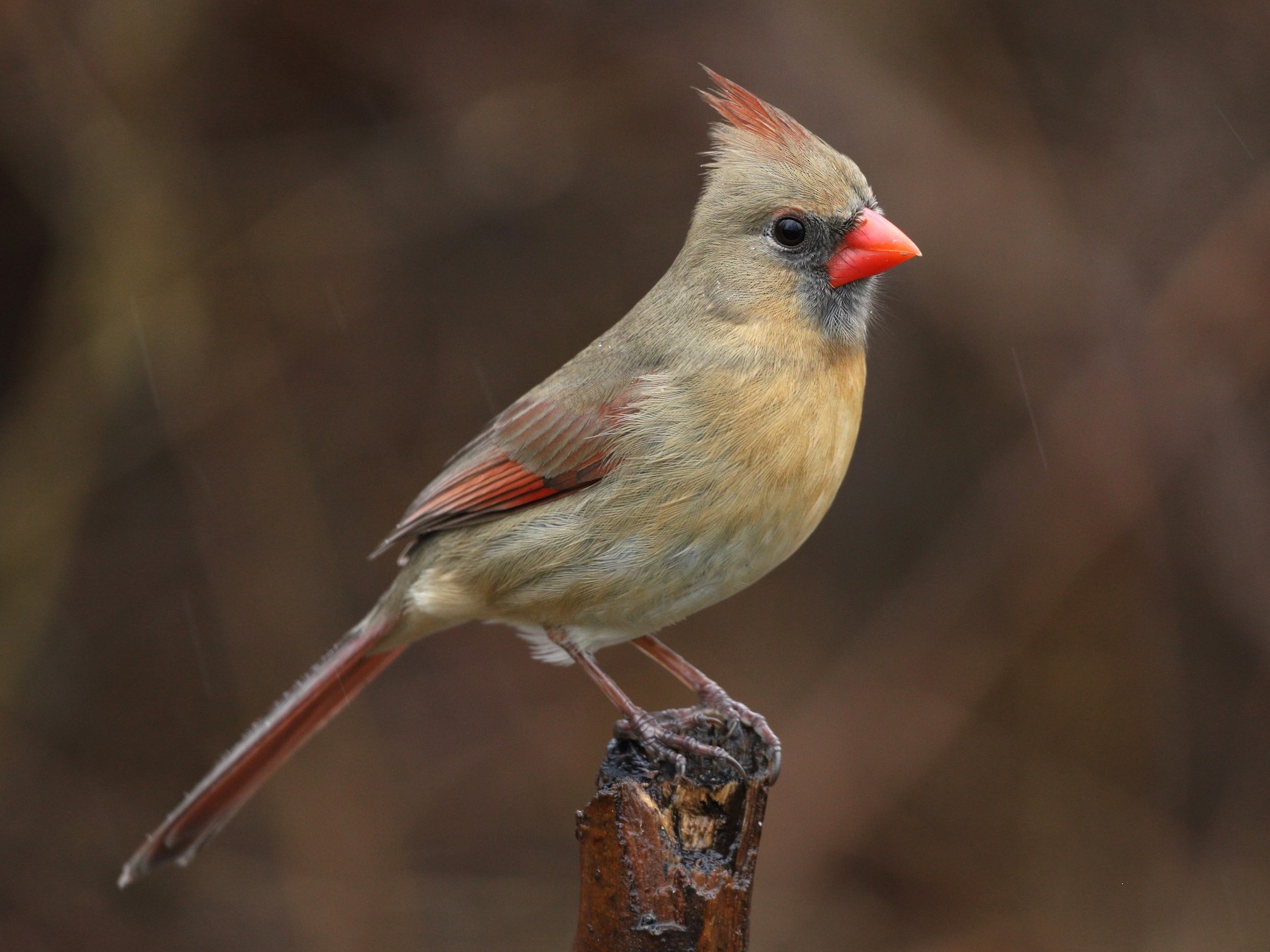
Northern Cardinals are a perennial presence in Missouri, being sighted consistently throughout the year. These non-migratory birds make an appearance in 70% of bird watching summer checklists and 62% of winter ones in the state.
Female Northern Cardinals are subtly flashy, adorned with a brown hue, a distinct brown crest, red accents, and red beaks.
On the other hand, male Northern Cardinals, with their vibrant red plumage, black face markings, red crests, and beaks, present a striking contrast, particularly against a snowy winter backdrop.
Scientifically known as Cardinalis cardinalis, these birds measure between 8.3-9.1 inches in length, weigh between 1.5-1.7 ounces, and have a wingspan ranging from 9.8-12.2 inches. Northern Cardinals inhabit the eastern half of the US, and some southern states extending as far west as Arizona.
These birds are typically found amidst dense foliage, busily foraging for seeds, fruits, and insects. During breeding season, Northern Cardinals may display aggressive behavior, even attacking their own reflection as they zealously guard their territories.
You can entice Northern Cardinals into your backyard by filling feeders with sunflower seeds, peanut hearts, millet, and milo. They will happily eat from large tube feeders, hoppers, platform feeders, or even pick food scattered on the ground.
2. Mourning Dove
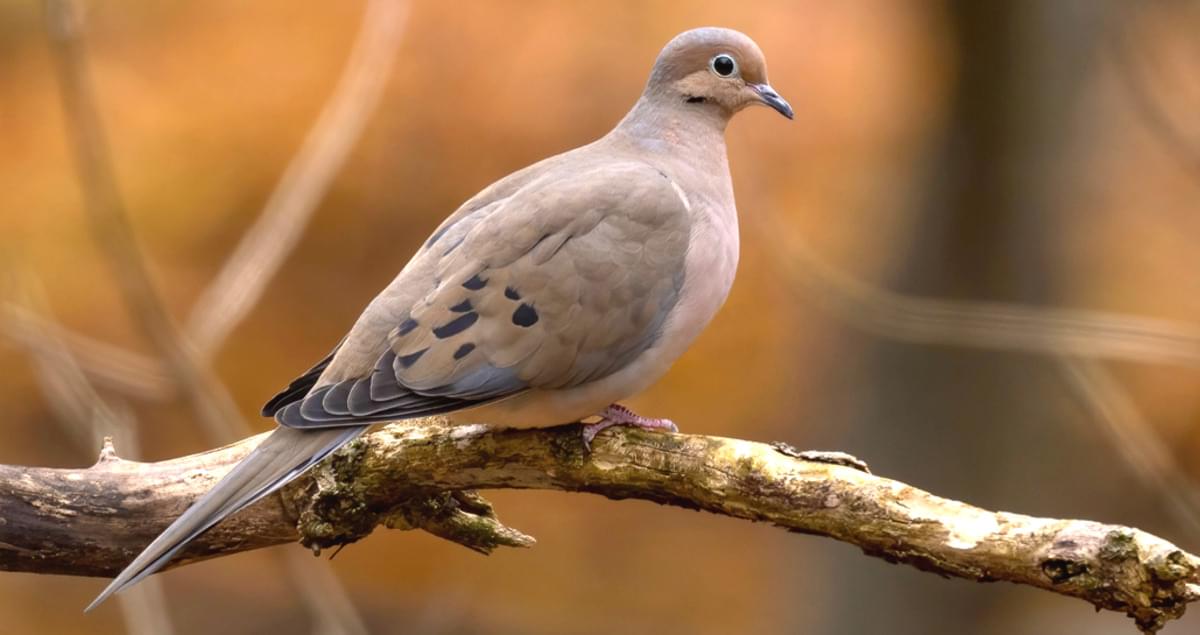
Mourning Doves, a constant sight in Missouri throughout the year, are seen more often between March and September, their breeding season. They feature on 54% of summer checklists and 34% of winter checklists.
These birds exude elegance with their compact heads, full bodies, and elongated tails. Their soft brown plumage is marked with black spots on the wings. The males tend to be slightly heavier than the females.
Scientifically known as Zenaida macroura, Mourning Doves measure between 9.1 to 13.4 inches in length, weigh between 3.0 to 6.0 ounces, and have a wingspan of 17.7 inches.
They can be found all year round in all of the lower 48 states but may migrate from the northern Midwest and southern Canada after their breeding season.
Mourning Doves are often spotted perched on telephone wires or seeking seeds on the ground in grasslands, fields, and backyards. They also inhabit open areas or the peripheries of woodlands.
To invite Mourning Doves into your backyard, scatter millet on the ground or platform feeders. They also enjoy black sunflower seeds, nyjer, cracked corn, and peanut hearts.
3. American Robin
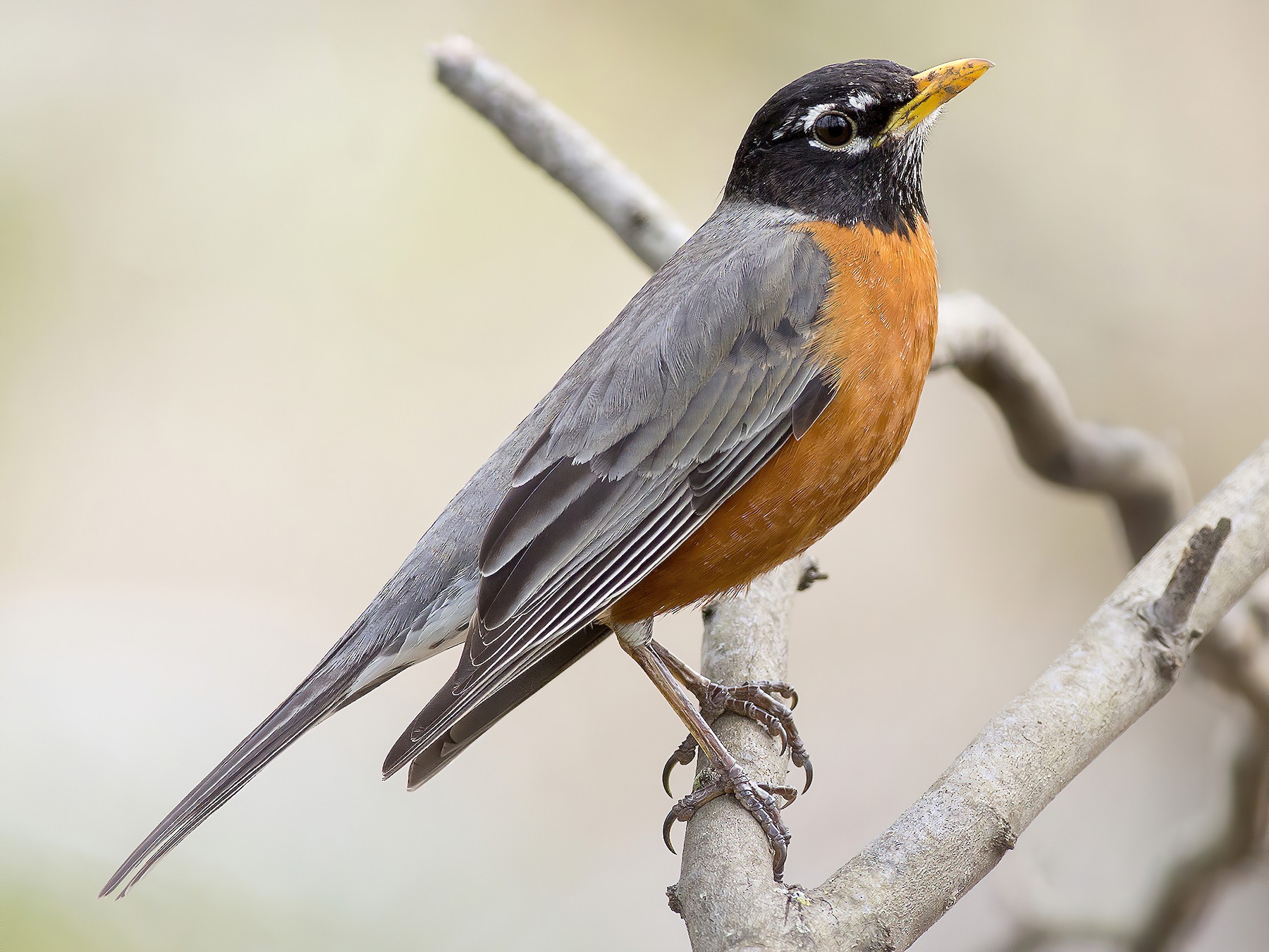
American Robins are year-round residents of Missouri, with a notable presence during their breeding season. They feature in 52% of summer bird-watching checklists and 31% of winter ones for the state.
A common sight on lawns hunting for earthworms, American Robins have black heads and backs contrasted by red or orange breasts. During winter, they typically roost in trees, making them a more frequent sight in backyards from spring onwards.
Scientifically named Turdus migratorius, these birds measure between 7.9 to 11.0 inches in length, weigh between 2.7 to 3.0 ounces, and have a wingspan ranging from 12.2 to 15.8 inches.
They are permanent residents in the lower 48 states, along with the coasts of western Canada and Alaska. However, those that breed in Canada and inland Alaska migrate south during the winter.
American Robins inhabit a variety of environments, including woodlands, forests, mountains, fields, parks, and lawns. Their diet primarily consists of earthworms, insects, snails, and fruit.
To draw American Robins into your backyard, provide sunflower seeds, suet and peanut hearts, fruits, and mealworms. Platform feeders or food scattered on the ground work best. Planting native plants that bear berries, such as juniper, sumac, hawthorn, and dogwood, can also be an effective lure.
4. American Goldfinch – Female

American Goldfinches are a year-round presence in Missouri, appearing in 39% of summer bird-watching checklists and 35% of winter ones.
These birds are a favorite among birdwatchers, particularly in the spring when the males display vibrant yellow and black plumage. Females, on the other hand, and males during the winter, exhibit a more muted brown coloring.
Known scientifically as Spinus tristis, American Goldfinches measure between 4.3 to 5.1 inches in length, weigh between 0.4 to 0.7 ounces, and have a wingspan ranging from 7.5 to 8.7 inches.
They inhabit most parts of North America, generally staying in the same area all year round. However, those that breed in Canada and the Midwest typically migrate to the southern states in the US during winter.
American Goldfinches can be found foraging for sunflower, thistle, and aster plants in weedy fields and overgrown regions. They are also a common sight in suburban areas, parks, and backyards.
To encourage American Goldfinches to visit your backyard, consider planting thistles and milkweed. They are also likely to frequent bird feeders, particularly if filled with their preferred foods: sunflower and nyjer seeds.
5. Carolina Wren

Carolina Wrens are permanent residents of Missouri, appearing consistently throughout the year. They feature in 33% of summer bird-watching checklists and 29% of winter ones.
These elusive birds sport a dark brown coloration on their upper bodies, while their underbellies are a lighter brown. Characteristic features include a white eyebrow stripe, an upright tail, and a distinctive, loud ‘teakettle’ song.
Scientifically named Thryothorus ludovicianus, Carolina Wrens measure between 4.7 to 5.5 inches in length, weigh between 0.6 to 0.8 ounces, and boast a wingspan of 11.4 inches.
These birds inhabit the eastern and southeastern US states year-round. They can typically be found in woodland environments or areas with dense vegetation, but they are also known to visit backyard feeders.
To attract Carolina Wrens to your backyard feeders, offer suet, hulled sunflower seeds, or peanut hearts in large tube or platform feeders.
While some wren species in Missouri are often seen in backyards, to observe others, you may need to venture into marshy habitats.
6. House Sparrow
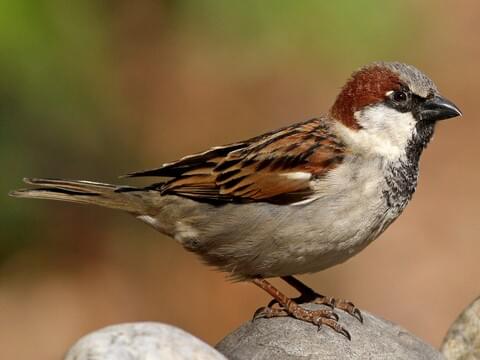
House Sparrows, an introduced species, are present in Missouri throughout the year. They are non-migratory birds and are reported in about 28% of summer bird-watching checklists and 25% of winter ones.
Having successfully adapted to new environments, House Sparrows are now among the most widespread bird species. They exhibit gray and brown heads, white cheeks, and a blend of black and brown on their backs, with gray on their underparts.
Scientifically known as Passer domesticus, House Sparrows measure between 5.9 and 6.7 inches in length, weigh between 0.9 and 1.1 ounces, and have a wingspan ranging from 7.5 to 9.8 inches.
House Sparrows can be found across the US and southern Canada all year round. They usually inhabit areas close to human dwellings and are known for their relative tameness, often eating from people’s hands.
Their diet mainly consists of grains and seeds, along with food scraps. Despite being considered pests due to their non-native status and pervasive presence—even in backyards where food is not explicitly provided—they’ve become a common sight.
To attract House Sparrows to your backyard feeders, you can use a variety of birdseeds, such as millet, corn, and sunflower seeds.
7. House Finch – Female

House Finches are a constant presence in Missouri throughout the year. They don’t migrate, and they show up in 24% of summer bird-watching checklists and 28% of the ones from winter.
Female House Finches sport an all-over brown-streaked appearance, whereas male House Finches are notable for their red head and breast, with the remainder of their bodies carrying predominantly brown streaks.
The scientific name for House Finches is Haemorhous mexicanus. They measure between 5.1 and 5.5 inches in length, weigh between 0.6 and 0.9 ounces, and have a wingspan that ranges from 7.9 to 9.8 inches.
House Finches originally inhabited the western regions of the US, but after being introduced to the eastern parts of the country, they’ve thrived and even displaced the Purple Finch in some areas.
These birds are easily spotted in various settings such as parks, farms, the edges of forests, and backyard feeders. They often gather in boisterous groups that are difficult to overlook.
If you want to attract House Finches to your backyard feeders, you can use black oil sunflower seeds or nyjer seeds in tube feeders or platform feeders.
8. White-throated Sparrow

White-throated Sparrows are winter visitors in Missouri, making their presence known in 35% of the bird checklists during this season. They are typically spotted in this region from October through May.
These sparrows are easily identifiable due to their unique black and white striped heads, a vivid white throat, and a yellow spot between their eyes and beak. Their dorsal side is brown, while their ventral side is gray.
Their scientific name is Zonotrichia albicollis. They measure between 6.3 and 7.1 inches in length, weigh from 0.8 to 1.1 ounces, and exhibit a wingspan ranging from 7.9 to 9.1 inches.
White-throated Sparrows are migratory creatures, primarily breeding in Canada and then migrating south to the eastern and southern regions of the US, along with the Pacific Coast, during winter.
These birds can be spotted on the forest floor or along the peripheries of wooded areas, usually congregating in substantial flocks.
White-throated Sparrows mainly feed on seeds from grasses and weeds, along with fruits like grapes, sumac, mountain ash, blueberries, blackberries, and dogwood. They also consume a variety of insects picked from the forest floor, particularly during the summer months.
To attract White-throated Sparrows to your backyard, you can use millet and black oil sunflower seeds on platform feeders.
9. Northern Flicker
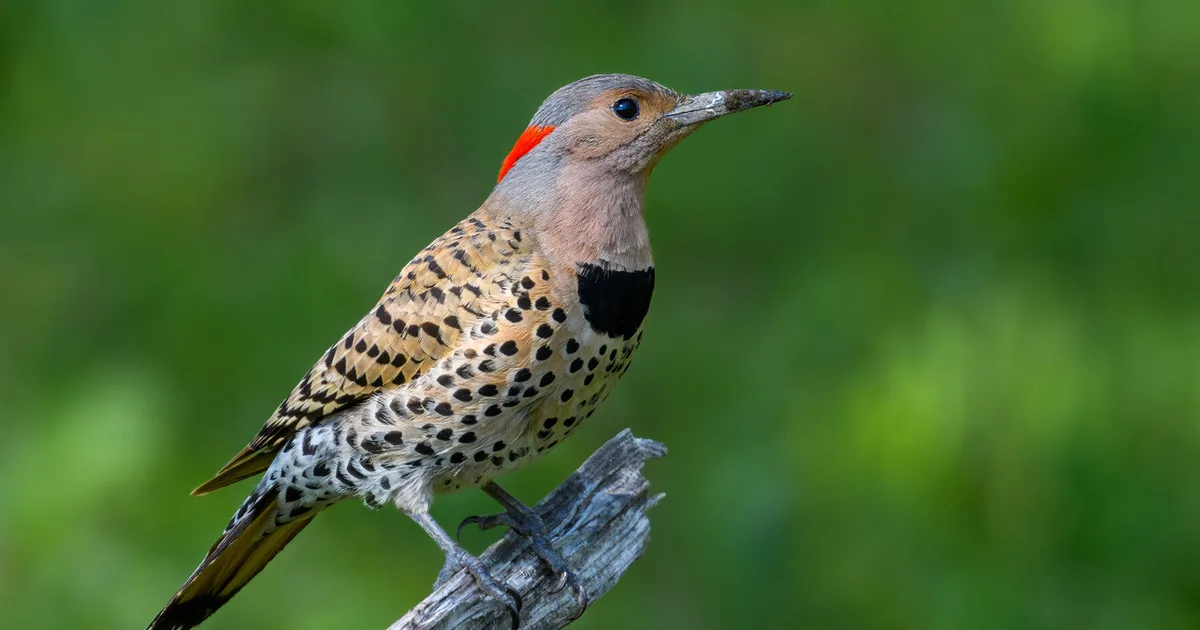
Northern Flickers, a species of large brown woodpeckers, can be seen throughout the year in Missouri. Their population swells notably during the October migration period. They show up in 10% of the state’s birdwatching checklists in summer, 24% in winter, and peak at 39% during the fall migration.
These sizable woodpeckers have black spots and exhibit a white patch on their rump when in flight. Male Northern Flickers are distinguishable by the red nape on their neck.
Interestingly, the flashes of color in their wings and tail reveal their regional origins. Red-shafted birds are native to the west, while yellow-shafted ones hail from the east.
Their scientific name is Colaptes auratus. The bird measures between 11.0 and 12.2 inches in length, weighs from 3.9 to 5.6 ounces, and has a wingspan ranging from 16.5 to 20.1 inches.
Northern Flickers can be found across the entirety of the US throughout the year, and in Canada during summer. Those breeding in Canada migrate south when winter sets in.
Primarily feasting on ants and beetles, Northern Flickers also enjoy fruits and seeds. They are often seen on the ground, using their curved bill to forage.
To draw Northern Flickers to your backyard, consider using suet in your bird feeders. Additionally, other types of woodpeckers in Missouri might also pay a visit to your feeders.
10. Brown-headed Cowbird – Female
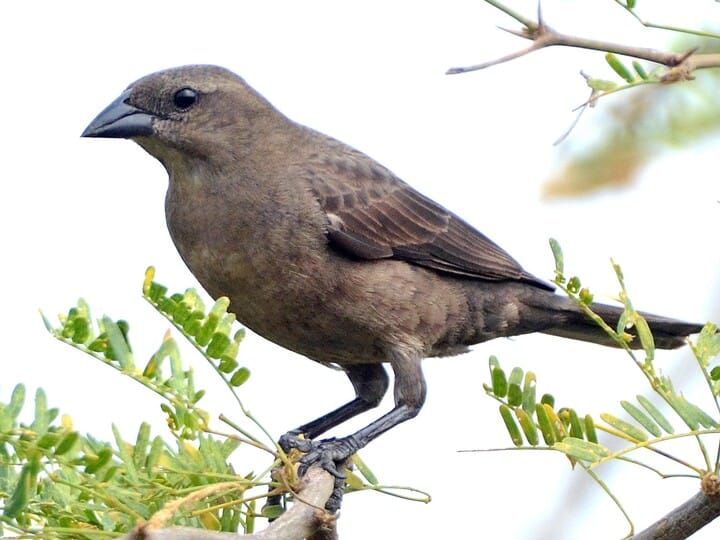
Brown-headed Cowbirds are typically present in Missouri from March through August, migrating southward when summer ends. However, some do linger throughout the winter. They are recorded in 38% of the state’s summer birdwatching checklists and make a scanty appearance in 2% of winter checklists.
Female Brown-headed Cowbirds possess an overall brown coloration with subtle streaking. The males, larger than their female counterparts, feature black bodies, brown heads, and compact tails.
Their scientific name is Molothrus ater. Their body length ranges from 7.6 to 8.7 inches, they weigh between 1.3 and 1.8 ounces, and they have a wingspan of about 14.2 inches.
Brown-headed Cowbirds are year-round residents in the eastern and southern states of the US, and along the Pacific Coast. However, those breeding in the northern and western states of the US, as well as Canada, migrate southward during winter.
They are often viewed unfavorably due to their parasitic breeding habits. They destroy the eggs of smaller songbirds and then lay their own eggs in these nests, effectively outsourcing the rearing of their offspring to the unsuspecting foster bird.
11. Song Sparrow
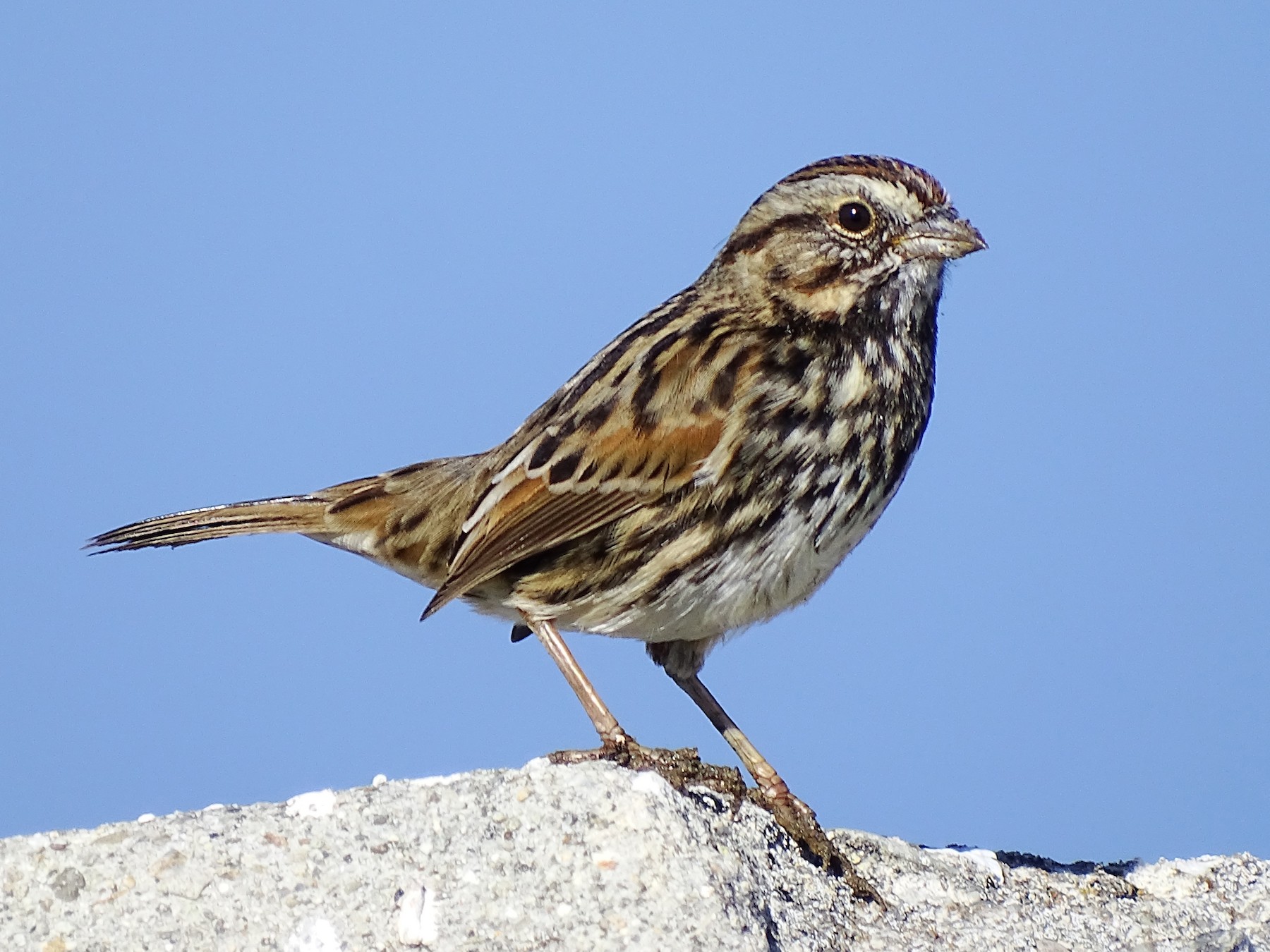
Song Sparrows are year-round residents in Missouri, showing up in 12% of the state’s summer bird-watching checklists and 17% during winter.
While they may not be as visually striking as some other backyard birds, Song Sparrows, primarily brown with streaked markings, make their presence known through their near ceaseless song during the spring and summer mating seasons.
Their scientific name is Melospiza melodia. They range in length from 4.7 to 6.7 inches, weigh between 0.4 and 1.9 ounces, and have a wingspan of 7.1 to 9.4 inches.
Song Sparrows are permanent inhabitants of the northern United States. However, those that breed in Canada tend to migrate to the southern US for the winter season.
These birds can often be found in open spaces with shrubbery and wetlands. They frequently perch on low shrubs while singing and are common visitors to backyard feeders.
Song Sparrows have a diverse diet that includes a wide array of insects and plant matter, such as beetles, caterpillars, midges, spiders, earthworms, buckwheat, sunflower, raspberries, wild cherries, blackberries, wheat, and rice.
To attract Song Sparrows to your backyard feeders, offer black oil sunflower seeds, cracked corn, and nyjer on platform feeders.
Missouri is home to a surprisingly rich variety of sparrows. Learning their distinctive songs and interesting facts about them can aid in easier identification.
12. Eastern Phoebe

Eastern Phoebes are typically seen in Missouri during their breeding season, showing up on 24% of the state’s summer bird-watching checklists. While they are most commonly spotted between March and October, a few can be observed throughout the year.
These robust songbirds sport a grayish-brown hue on their back, a contrasting darker head, and a whitish underbelly.
Scientifically known as Sayornis phoebe, these birds measure between 5.5 to 6.7 inches in length, weigh approximately 0.6 to 0.7 ounces, and have a wingspan that stretches from 10.2 to 11.0 inches.
Eastern Phoebes are migratory creatures that breed across the northeastern and central US, extending into Canada. They usually head south to the southeastern states of the US and Mexico during the winter, although some may choose to stay in the southern parts of their range all year round.
These birds have a preference for peaceful woodlands and can often be seen alone on low perches, their tails wagging subtly. They are not typically found in pairs or large groups.
Being a type of flycatcher, the Eastern Phoebe’s diet primarily consists of flying insects. However, they also consume spiders, other insects, small fruits, and seeds. They are known to build their nests out of mud and grass, often choosing bridges, barns, or houses as their nesting sites.
You can attract Eastern Phoebes to your backyard by installing a nest box or planting native vegetation that bears berries.
13. Chipping Sparrow
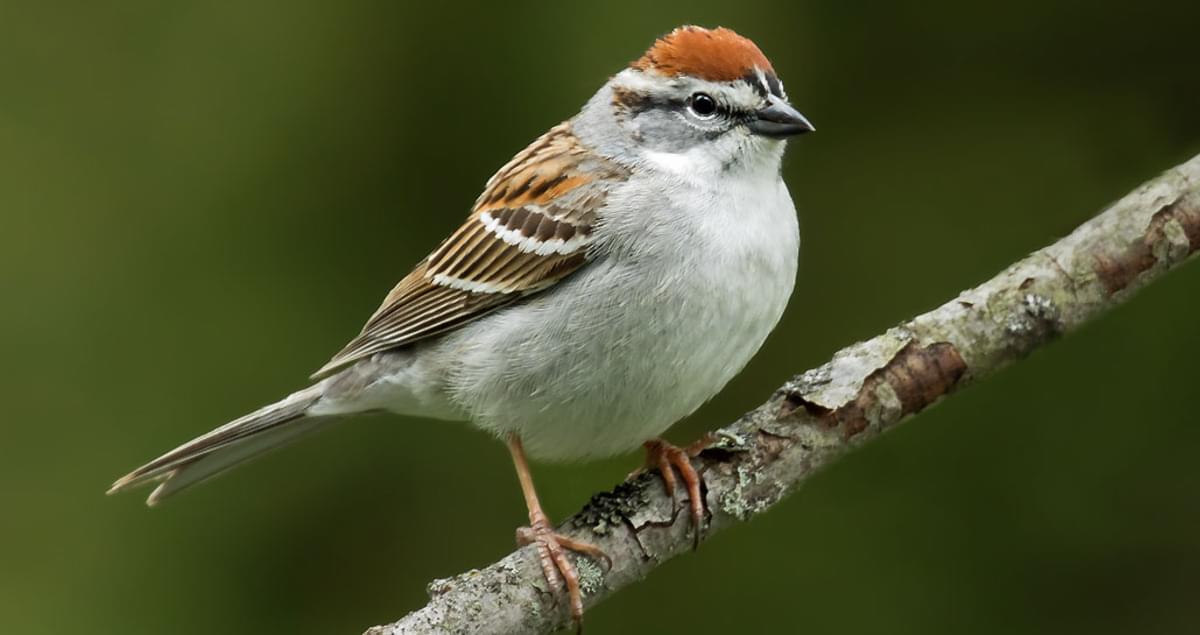
During their breeding season, Chipping Sparrows can be seen in Missouri, showing up on about 21% of the state’s summer bird-watching lists. These birds are typically observable from April to October, though a small number can be found year-round in the southern parts of the state.
Chipping Sparrows are slim, long-tailed birds with a grayish underbelly and a back streaked with brown and black. They possess a distinct rusty crown and a black line across their eye. However, their vibrant colors tend to mellow down during the winter.
Known scientifically as Spizella passerina, these birds range from 4.7 to 5.9 inches in length, weigh around 0.4 to 0.6 ounces, and have a wingspan of approximately 8.3 inches.
During the summer, Chipping Sparrows breed across the US and Canada, migrating to Mexico and Florida for the winter. Some choose to stay in the southern states throughout the year.
Chipping Sparrows often gather in small groups on open ground, and they are frequent visitors to backyards, attracted by various types of birdseed.
To draw Chipping Sparrows to your backyard, offer them seeds or cracked corn on open feeders, such as hopper or platform feeders.
14. Brown Thrasher

Brown Thrashers are year-round residents in Missouri, with their presence being most noticeable from April to July. They make an appearance in 19% of the state’s summer bird surveys and a mere 1% of winter checklists.
These large songbirds, similar in size to a robin, possess a long and proportional body. Their back is adorned with brown feathers, while their chests and bellies showcase white streaks. Their faces are gray and are highlighted by their bright yellow eyes.
Scientifically known as Toxostoma rufum, Brown Thrashers measure about 9.1-11.8 inches in length, weigh between 2.1 and 3.1 ounces, and have a wingspan ranging from 11.4 to 12.6 inches.
Inhabiting central and eastern North America, Brown Thrashers residing in the southeast regions stay year-round, while those in northern areas migrate south during the colder months.
Despite their size, Brown Thrashers can be difficult to spot as they spend most of their time hidden in underbrush. They can often be detected by the sound of their rummaging in the leaf litter and soil as they search for insects. Apart from insects, their diet also includes berries and beetles, and they have been known to catch flying insects mid-air.
These remarkable songbirds boast a repertoire of over 1000 different songs, one of the most extensive of any North American songbird.
To entice Brown Thrashers into your backyard, consider planting dense shrubbery and berry-bearing plants. They are also known to gather fallen seeds from underneath bird feeders.
15. Field Sparrow
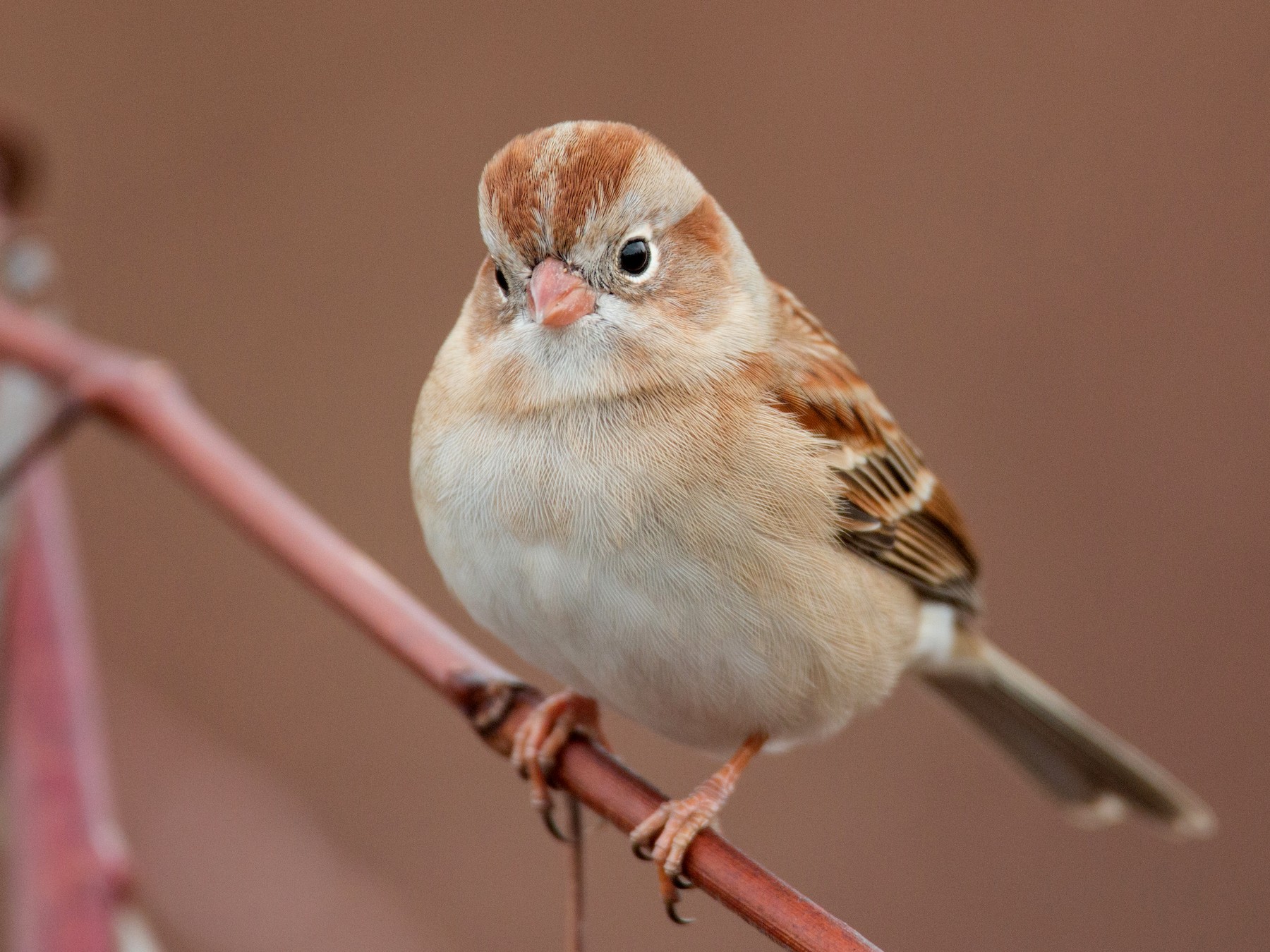
Field Sparrows are a regular feature in Missouri, appearing in 15% of the state’s summer bird surveys. They are most frequently seen between April and August, although a small number are year-round residents, as evidenced by their appearance in 2% of winter bird checklists.
These slender birds sport a brown back streaked with black. Their underbelly and head are gray, and they feature a distinctive reddish crown and pink bill.
Known scientifically as Spizella pusilla, Field Sparrows have a length between 4.7 and 5.9 inches, weigh between 0.4 and 0.5 ounces, and possess a wingspan of approximately 7.9 inches.
Field Sparrows are year-round inhabitants of the eastern United States. However, those that breed in the Midwest migrate south to escape the harsh winter months.
During the breeding season, male Field Sparrows are easier to spot as they tend to perch and sing in the early morning hours. Otherwise, these shy birds can be overlooked, quietly feeding on weeds and seeds and preferring the solitude of abandoned fields.
Their nests, initially built on the ground for the first brood, are gradually constructed higher as the breeding season progresses. These nests, made from grass, can hold up to five eggs which typically hatch within two weeks. The fledglings then leave the nest approximately a week later.
To draw Field Sparrows to your backyard, consider offering cracked corn, hulled sunflower seeds, and millet.
16. Common Yellowthroat
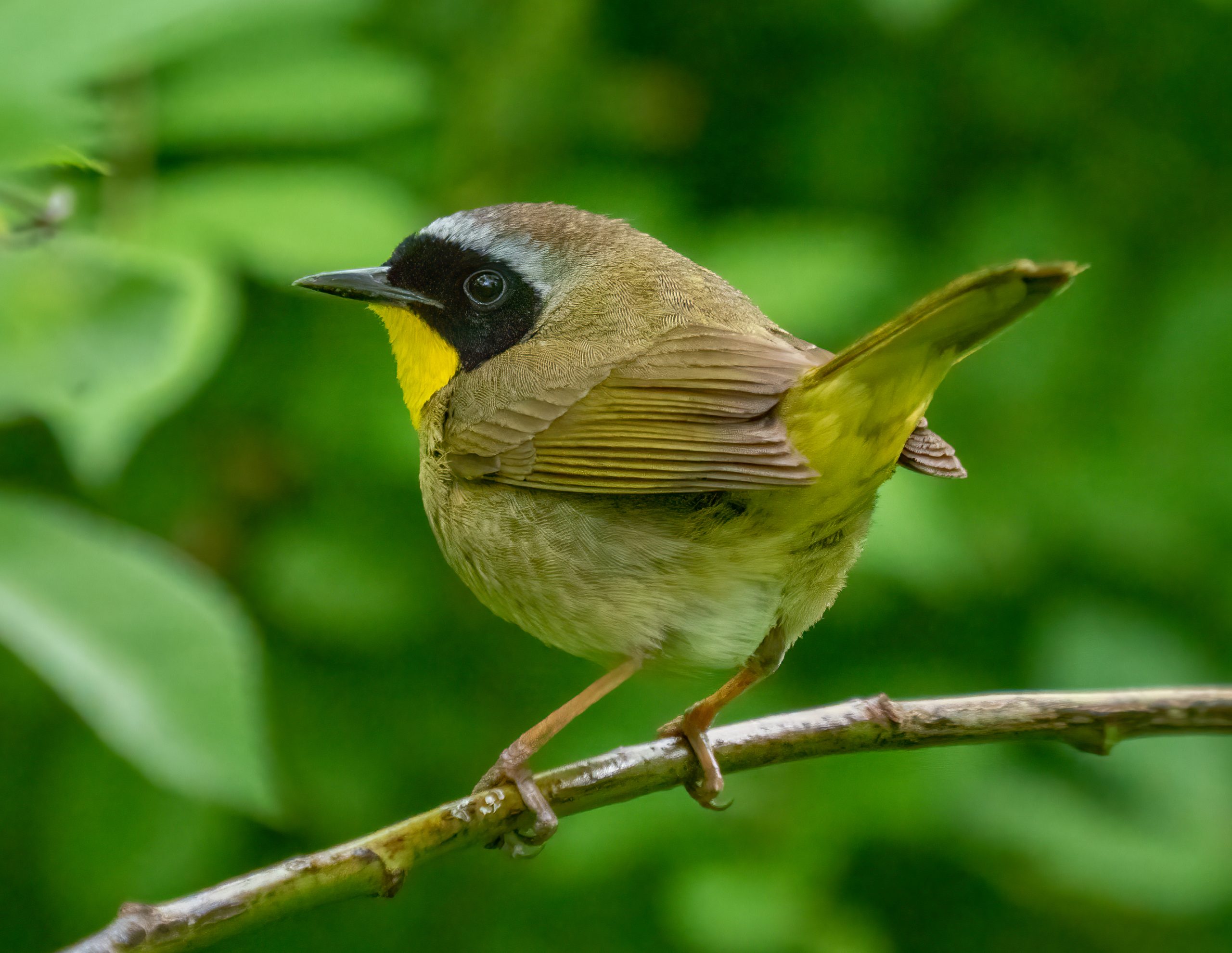
Usually visible in Missouri during their breeding season, Common Yellowthroats are predominantly observed between April and October, making an appearance in approximately 24% of summer bird checklists.
These small songbirds exhibit a brownish hue on their back, complemented by bright yellow on their underparts and long tails. Male specimens are identifiable by their distinct black facial masks. Depending on their geographical location, their yellow coloration may vary, and they may exhibit more olive tones on their underside.
With the scientific name Geothlypis trichas, these birds measure 4.3-5.1 inches in length, weigh about 0.3 ounces, and display a wingspan ranging from 5.9 to 7.5 inches.
Common Yellowthroats inhabit most of North America during their summer breeding season, excluding Alaska and the northern regions of Canada. Some of these birds remain year-round along the Gulf Coast and in the Pacific Southwest, while others migrate south during the winter months.
These birds are typically found in marshy or wetland environments and brushy fields, where they thrive in dense, tangled vegetation.
Attracting Common Yellowthroats to spacious backyards can be achieved by cultivating dense vegetation and planting native species that attract insects.
Common Yellowthroats are just one type of warbler that can be observed in Missouri. There are numerous others that captivate observers with their enchanting songs, which you can listen to and learn.
17. Eastern Towhee
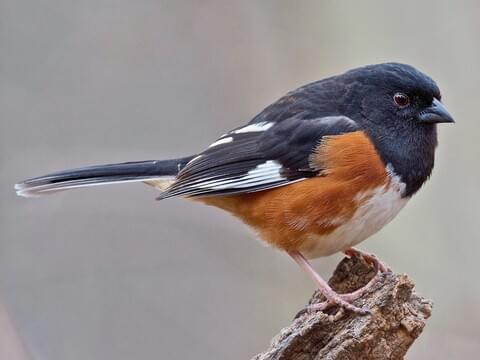
Eastern Towhees are commonly seen in Missouri during their breeding season, which spans from mid-March to October. They make an appearance in approximately 13% of the summer bird checklists, although some individuals do reside in the state throughout the year.
These birds are large sparrows, comparable in size to a Robin. Males are easily recognized by their black head, throat, and back, complemented by reddish flanks, long tails, and a white belly. Females bear a similar pattern but display brown instead of black.
Scientifically known as Pipilo erythrophthalmus, Eastern Towhees measure between 6.8-8.2 inches in length, weigh about 1.1-1.8 ounces, and possess a wingspan ranging from 7.9 to 11.0 inches.
Eastern Towhees predominantly inhabit the southeastern regions of the United States year-round. However, those dwelling in the northern parts of their range migrate south during the winter months.
These birds are often found foraging in the underbrush and at the fringes of forests and thickets.
Eastern Towhees typically construct their nests on the ground, camouflaged amidst fallen leaves. Their nests are constructed from twigs, bark, and leaves, and lined with soft grass and animal fur. They lay up to six eggs, which usually hatch in just under two weeks, and the fledglings leave the nest approximately two weeks later.
Attracting Eastern Towhees to your backyard can be achieved by maintaining overgrown borders and setting up platform feeders filled with black oil sunflower seeds, hulled sunflower seeds, cracked corn, and millet.
18. White-crowned Sparrow
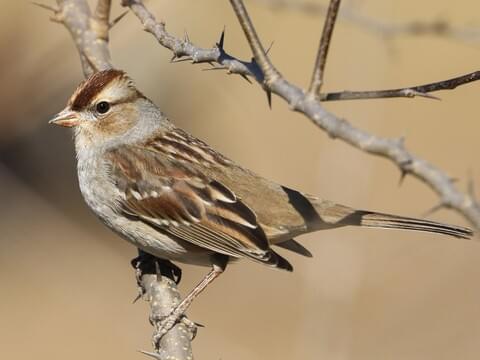
White-crowned Sparrows are typically seen in Missouri during the winter months, from October through May, and feature in approximately 11% of the state’s winter bird checklists.
These birds are sizable gray sparrows with long tails and small beaks. Their most distinguishing feature is the striking black and white stripes adorning their heads.
The scientific name for the White-crowned Sparrow is Zonotrichia leucophrys. They measure between 5.9 to 6.3 inches in length, weigh around 0.9 to 1.0 ounces, and have a wingspan ranging from 8.3 to 9.4 inches.
White-crowned Sparrows breed in Alaska and the Arctic regions of Canada, then migrate south to the contiguous United States and Mexico for the winter. However, some may choose to stay along the Pacific Coast and the mountainous regions of the west throughout the year.
These sparrows can be found in a variety of habitats, including weedy fields, along roadsides, at the edges of forests, and even in backyards. They primarily forage for weed and grass seeds and are partial to fruits like elderberries and blackberries.
When it comes to nesting, White-crowned Sparrows use twigs, grass, moss, and pine needles to construct their homes, usually low in shrubs or on the tundra ground. They lay up to seven eggs, which take around two weeks to hatch, and the fledglings are ready to leave the nest about nine days later.
You can attract White-crowned Sparrows to your backyard by offering them sunflower seeds. They are also known to feed on seeds that other birds have dropped from the feeders.
19. Great-crested Flycatcher
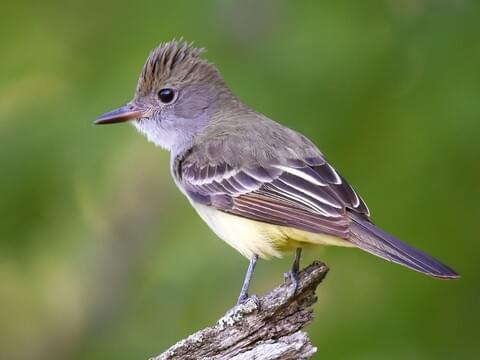
Great Crested Flycatchers inhabit Missouri during their breeding season, which spans from April to September. They feature in about 24% of the state’s summer bird checklists.
These birds showcase a brown back and a yellow belly contrasted by a gray throat. Their wing and tail feathers boast a hint of red, and they have a crest, though it’s not overly prominent.
Known scientifically as Myiarchus crinitus, these birds measure between 6.7 to 8.3 inches in length, weigh about 0.9 to 1.4 ounces, and have a wingspan of roughly 13.4 inches.
Great Crested Flycatchers breed across a vast region of eastern North America. During winter, they migrate to warmer climates, namely southern Florida, southern Mexico, and Central America.
These flycatchers typically position themselves high up in trees within woodlands, awaiting their prey, which largely consists of large flying insects such as butterflies, grasshoppers, moths, wasps, and spiders. You can find them in mixed woodlands, parks, neighborhoods lined with trees, and at the edges of open areas. They can also be seen perched on man-made structures like fence posts. Apart from insects, they enjoy small fruits and berries.
To attract Great Crested Flycatchers to your backyard, consider planting native plant species and leaving brush piles to entice insects. They also favor berry-producing plants. Erecting a nest box in your backyard may also invite these birds as they are known to readily make homes in them.
20. House Wren
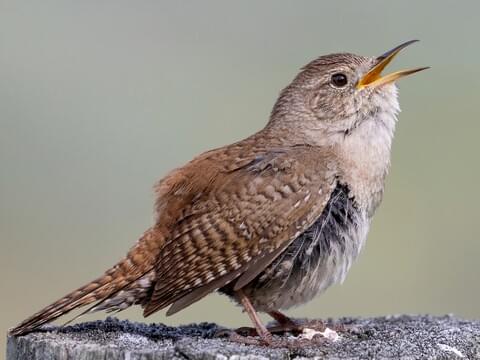
House Wrens are primarily observed in Missouri during the summer months, with their appearances recorded in about 17% of the checklists during this period. While a handful may be spotted throughout the year, the ideal timeframe to spot them spans from April to October.
In terms of appearance, House Wrens are small, unassuming brown birds with wings and tails featuring darker bars, and they display a lighter throat. They often hold their tails in an upright position.
Scientifically known as Troglodytes aedon, these birds measure between 4.3 to 5.1 inches in length, weigh approximately 0.3 to 0.4 ounces, and have a wingspan of about 5.9 inches.
House Wrens breed in the US and southern Canada during the summer before migrating to southern US states and Mexico to escape the winter chill.
These birds can be found in a variety of environments such as backyards, parks, and open woods, where they forage for insects and spiders. You can often observe them energetically hopping through tangled vegetation and low branches, their tails held high, periodically pausing to trill their merry tunes.
Despite their small stature, House Wrens exhibit aggressive behavior when it comes to securing the best nesting sites. They’ve been known to intimidate larger birds, sometimes going to the extent of removing eggs or nestlings from a nesting site they covet.
To make your backyard attractive to House Wrens, consider leaving brush piles or installing a nest box.
21. Cedar Waxwing
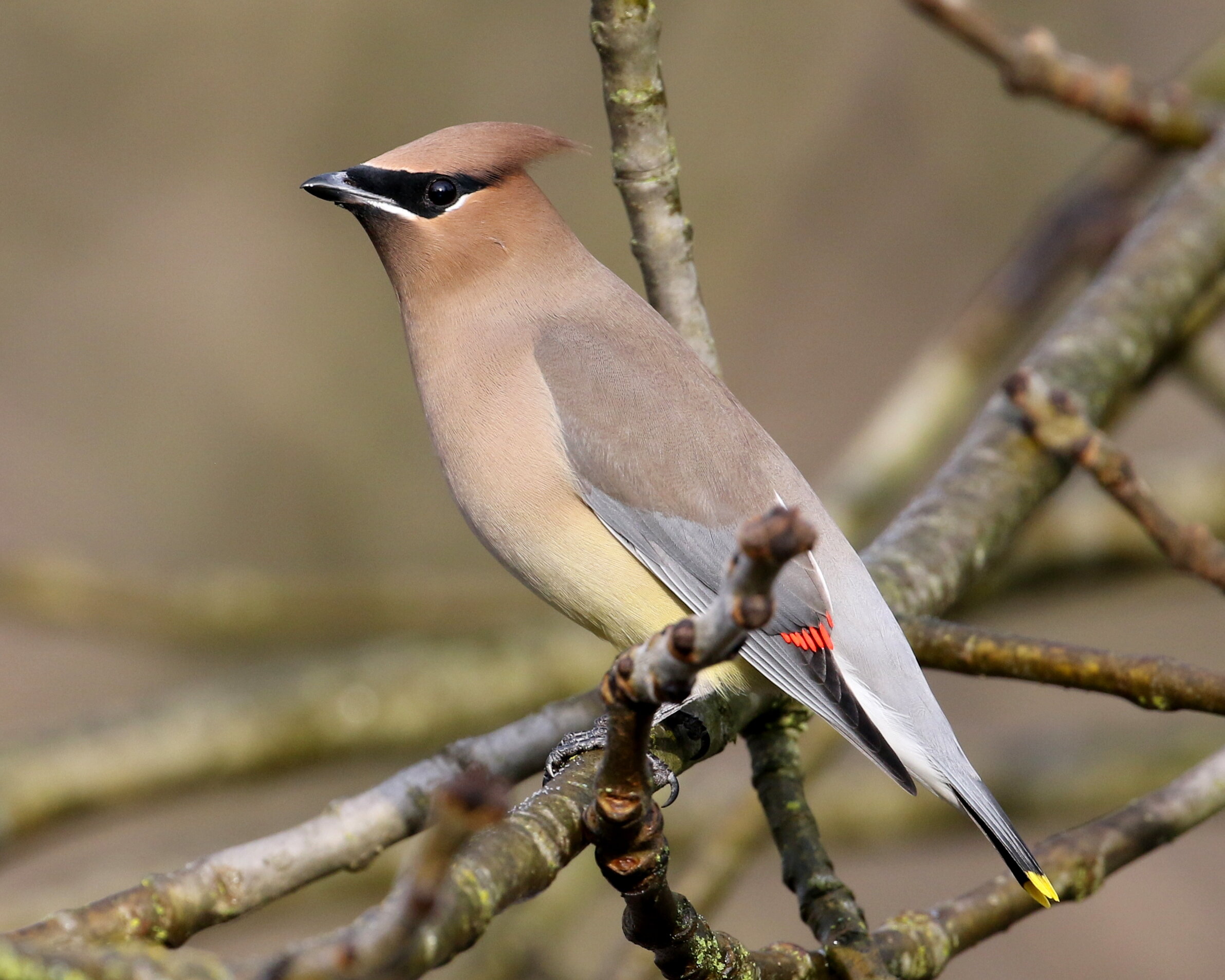
In Missouri, Cedar Waxwings are a familiar sight throughout the year, but they are particularly abundant during their migration periods in May and from September to November. These elegant and sociable birds display a beautiful coloration, with pale brown feathers on their head, chest, and crest, transitioning to gray on their back, wings, and tail.
The Cedar Waxwings’ distinctive appearance includes a pale yellow belly that becomes bright yellow near the tail. They possess a slender black mask over their eyes and sport bright red wingtips, adding a touch of vibrancy to their overall appearance.
Scientifically known as Bombycilla cedrorum, these birds measure approximately 5.5 to 6.7 inches (14-17 cm) in length and weigh around 1.1 ounces (32 g). Their wingspan ranges from 8.7 to 11.8 inches (22-30 cm).
While Cedar Waxwings can be found year-round in the northern half of the United States, those that breed in Canada migrate to the southern regions of the country for the winter months. Their vocalizations consist of high-pitched calls, and they tend to frequent areas with berry bushes, woodlands, and streams.
If you wish to attract Cedar Waxwings to your backyard, consider planting native trees and shrubs that bear small fruits, such as serviceberry, dogwood, juniper, winterberry, and hawthorn. Additionally, offering fruit on platform feeders can also entice these delightful birds to visit your space.
22. Swamp Sparrow

During the winter season, Swamp Sparrows can be observed in Missouri, but their population increases significantly during their migration periods in April and October. While they are present in around 4% of checklists during winter, their frequency rises to up to 12% during migration.
Identifiable by their distinct characteristics, Swamp Sparrows exhibit dark brown plumage on their backs, accompanied by rusty crowns and wings. Their breasts are gray, while their throats are white. Their heads are gray, featuring brown faces with a dark eye line, and their beaks sport a yellow tip.
Scientifically known as Melospiza georgiana, these birds measure approximately 4.7 to 5.9 inches (12-15 cm) in length, weigh between 0.5 and 0.8 ounces (15-23 g), and possess a wingspan of 7.1 to 7.5 inches (18-19 cm).
Swamp Sparrows primarily inhabit the eastern regions. They breed in Canada, northeastern US states, and North Central US states before embarking on their migration to eastern and southern US states, as well as Mexico.
True to their name, Swamp Sparrows can be found in wetlands, swamps, bogs, and coastal marshes. Their diet consists predominantly of seeds and fruits, particularly during winter, and shifts towards a higher proportion of insects during spring.
When constructing their nests, Swamp Sparrows typically choose concealed locations within vegetation, either on or near the ground. The nests are crafted using twigs, leaves, and cattails, and are lined with grass and other plant materials.
Under normal circumstances, Swamp Sparrows do not frequently visit residential backyards, except during migration when they may be attracted to yards with abundant vegetation and water sources.
23. Purple Finch – Female
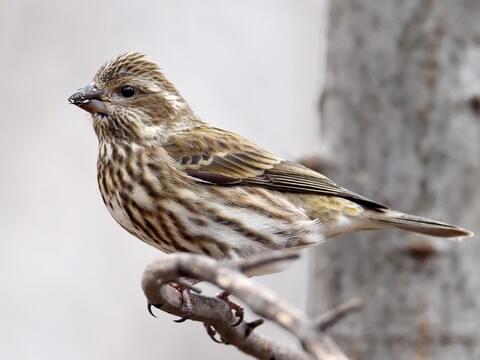
Purple Finches are a species of winter birds commonly found in Missouri. They begin arriving in September and some individuals stay until June, with the best months for spotting them being from October to mid-May. Approximately 9% of winter checklists include sightings of Purple Finches.
Female Purple Finches possess a brown-streaked plumage, while males exhibit reddish-purple heads and breasts, with more brown coloring on their backs and wings, and a lighter belly. Although they bear a resemblance to House Finches, Purple Finches are distinguished by their redder appearance, particularly at the upper portion of their back.
Scientifically known as Haemorhous purpureus, these birds measure around 4.7 to 6.3 inches (12-16 cm) in length, weigh between 0.6 and 1.1 ounces (18-32 g), and have a wingspan of approximately 8.7 to 10.2 inches (22-26 cm).
Purple Finches breed in Canada and migrate to eastern US states for the winter, but they can be found throughout the year in the northeastern region and along the Pacific coast.
When seeking out Purple Finches, look for them in evergreen forests where they feed on seeds, buds, nectar, and berries.
Nests of Purple Finches are typically situated high up in trees. Constructed using twigs, barks, weeds, and moss, the nests house three to five eggs, which are incubated for a period of thirteen days by the female.
To attract Purple Finches to your backyard, consider offering black oil sunflower seeds as a food source.
24. American Tree Sparrow
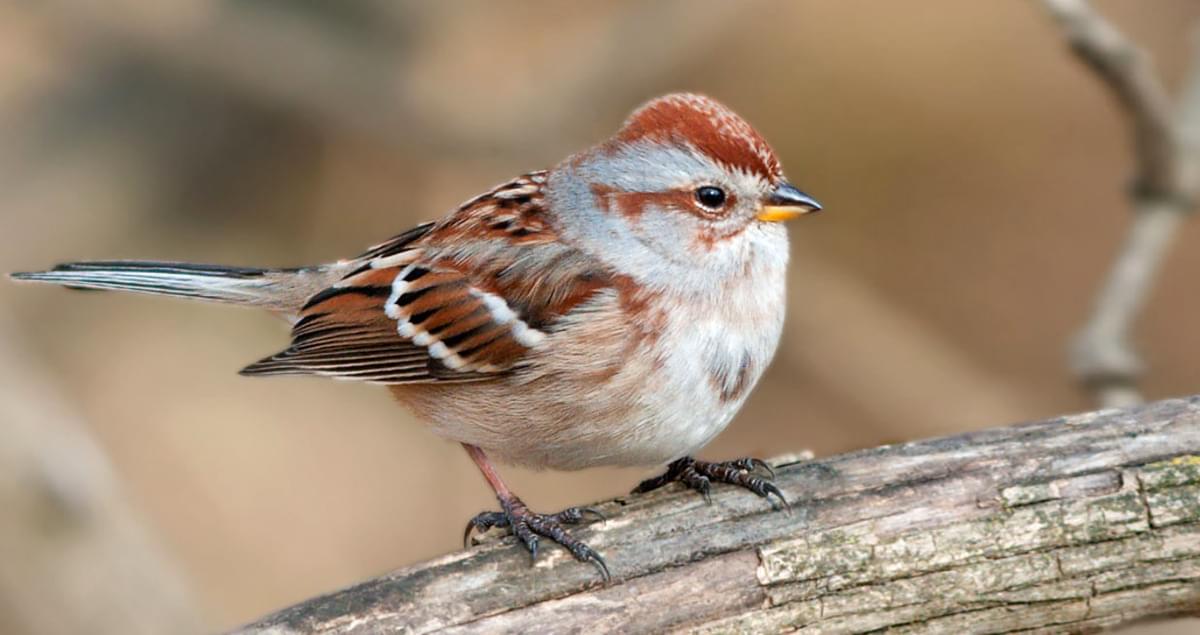
American Tree Sparrows choose to spend their winters in Missouri, with their arrival beginning in October. Some individuals remain until April, but the prime months to spot them are from November to February. Approximately 11% of winter checklists include sightings of these sparrows.
Distinguished by their plump and long-tailed appearance, American Tree Sparrows display brown-streaked feathers, rusty caps, gray faces, and a rusty eye line.
Scientifically known as Spizelloides arborea, these birds measure about 5.5 inches (14 cm) in length and weigh between 0.5 and 1.0 ounces (13-28 g). Their wingspan spans approximately 9.4 inches (24 cm).
American Tree Sparrows follow a unique pattern, as they are summer birds in Canada and winter birds in the United States. They breed in the northernmost regions of Canada and in Alaska, then migrate to various US states for the winter season, excluding areas along the Pacific and Gulf Coasts.
To locate American Tree Sparrows, look for them foraging in small flocks within weedy fields and beneath bird feeders.
Nests of American Tree Sparrows are typically situated on or near the ground and constructed using twigs, grass, and moss. They lay approximately five eggs, which take just under two weeks to hatch, and the young birds take a little over a week to fledge.
To attract American Tree Sparrows to your backyard, consider using platform feeders and provide them with black oil sunflower seeds, nyjer, cracked corn, and millet. They also feed on seeds that have fallen to the ground from tube feeders.
25. Rose-breasted Grosbeak – Female
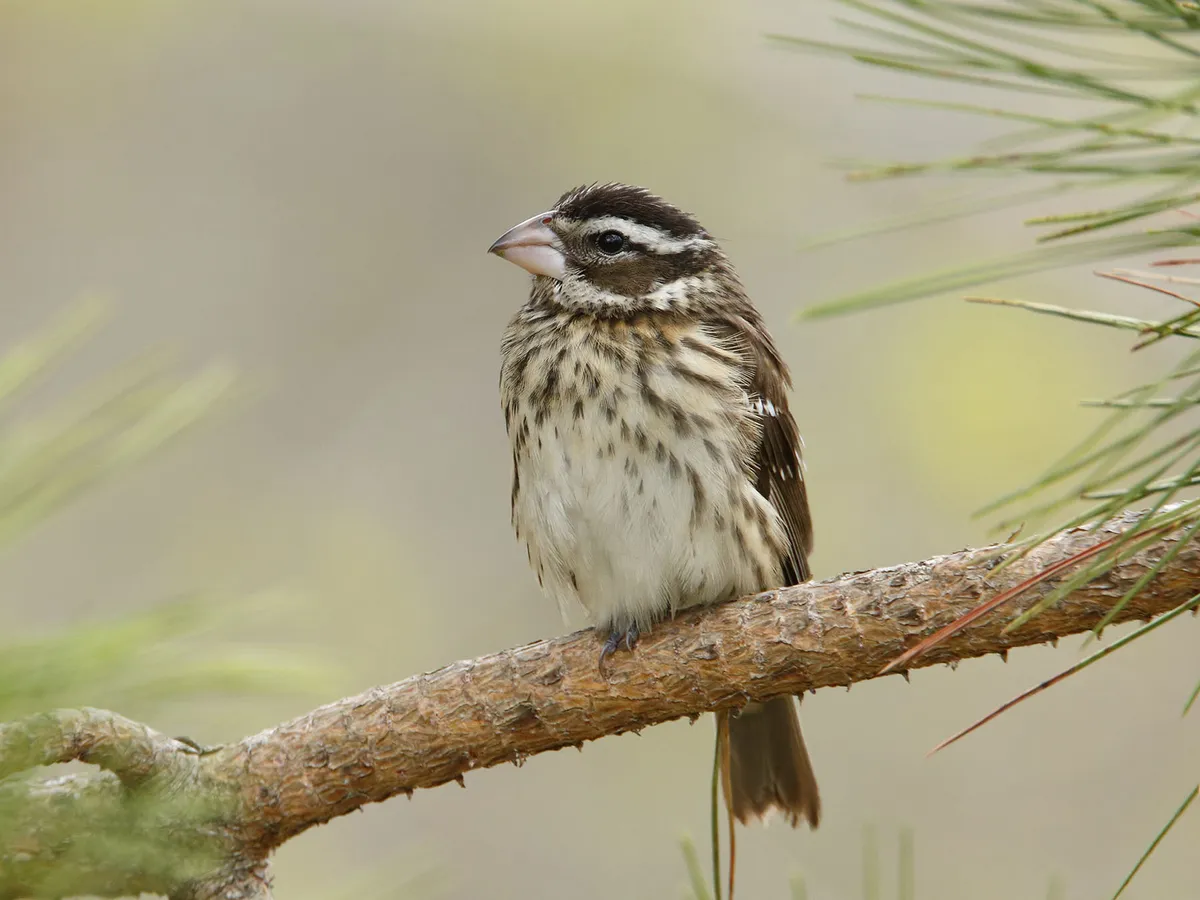
Rose-breasted Grosbeaks are a common sight in Missouri between April and November, with their highest abundance observed during migration. They appear on approximately 27% of checklists in the spring and 12% in the fall.
Female Rose-breasted Grosbeaks and immature males sport brown plumage with prominent streaking and a noticeable flash of yellow beneath their wings. In contrast, male Rose-breasted Grosbeaks display a striking black-and-white coloration, featuring black heads and backs, white bellies, and vibrant red breasts. They also exhibit a flash of red beneath their wings.
Scientifically known as Pheucticus ludovicianus, these grosbeaks measure around 7.1 to 8.3 inches (18-21 cm) in length and weigh approximately 1.4 to 1.7 ounces (39-49 g). Their wingspan spans about 11.4 to 13.0 inches (29-33 cm).
Rose-breasted Grosbeaks breed in northeastern US states, the Midwest, southern and central Canada, and can be spotted during migration in southeastern US states. During the winter months, they migrate to regions including Mexico, Central America, and the Caribbean.
You can find these grosbeaks foraging for insects, berries, and seeds in a variety of habitats, including forests, parks, and even backyards.
Nests of Rose-breasted Grosbeaks are typically situated in low tree branches. They are constructed using loosely-formed twigs, grass, and plants. The nests hold an average of five eggs, which take around two weeks to hatch. After hatching, both parents take turns incubating the eggs.
To attract Rose-breasted Grosbeaks to your backyard, consider providing them with sunflower seeds and peanuts, as these are favored food sources for them.
26. Swainson’s Thrush
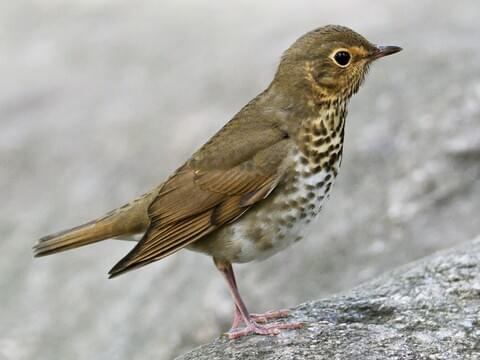
In Missouri, Swainson’s Thrushes are primarily observed during the months of April to May and September to October. They are documented in approximately 30% of checklists during the spring and 6% during the fall.
These medium-sized thrushes exhibit a pale underside with spotted chests and brown feathers on their backs.
Scientifically known as Catharus ustulatus, Swainson’s Thrushes measure around 6.3 to 7.5 inches (16-19 cm) in length, weigh between 0.8 and 1.6 ounces (23-45 g), and have a wingspan spanning 11.4 to 12.2 inches (29-31 cm).
You can find Swainson’s Thrushes in forests, where they forage along the forest floor, searching through leaf litter in pursuit of insects during the breeding season. They also consume red fruits such as blackberries, raspberries, huckleberries, and sumac. Ants form a part of their diet, and they feed other insects to their nestlings.
While Swainson’s Thrushes are typically seen only during migration in the spring and fall in the lower 48 states, they breed in Canada and Alaska before embarking on their journey to Central and South America for the winter season.
To attract Swainson’s Thrushes to your backyard, consider providing ground-level birdbaths for them to drink and bathe in. Additionally, offering tree and shrub cover will make your yard more enticing to these thrushes.
27. Savannah Sparrow
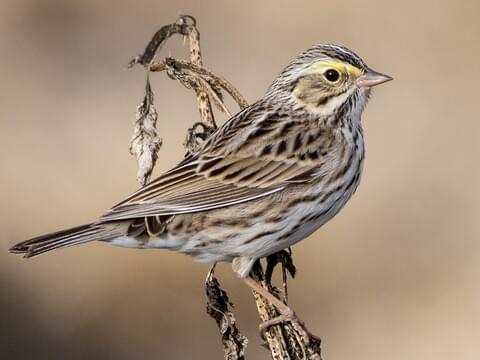
During the winter months, Savannah Sparrows can be found in Missouri, but their population increases significantly during the spring and fall migrations, particularly in April and October. They are recorded in approximately 3% of checklists during winter, but up to 8% during migration.
Upon closer observation, you will notice that Savannah Sparrows, characterized by their brown plumage, possess a distinct yellow patch near the eye. They also have short tails and display streaky brown coloring.
Scientifically known as Passerculus sandwichensis, these sparrows measure around 4.3 to 5.9 inches (11-15 cm) in length, weigh approximately 0.5 to 1.0 ounce (15-28 g), and have a wingspan ranging from 7.9 to 8.7 inches (20-22 cm).
Savannah Sparrows breed in Canada and the United States, then embark on a migration journey to southern US states and Mexico for the winter season.
When seeking Savannah Sparrows, look for them on the ground in open areas, such as grasslands, where they forage for insects and spiders during the breeding season, and seeds during winter.
Nests of Savannah Sparrows are typically situated on or near the ground and are constructed using grass. They lay up to six eggs, which take approximately two weeks to hatch. After hatching, it takes another one to two weeks for the young birds to fledge.
While these birds do not frequently visit feeders, they may visit your yard if you maintain brush piles, have long grass, and reside near fields.
28. Louisiana Waterthrush
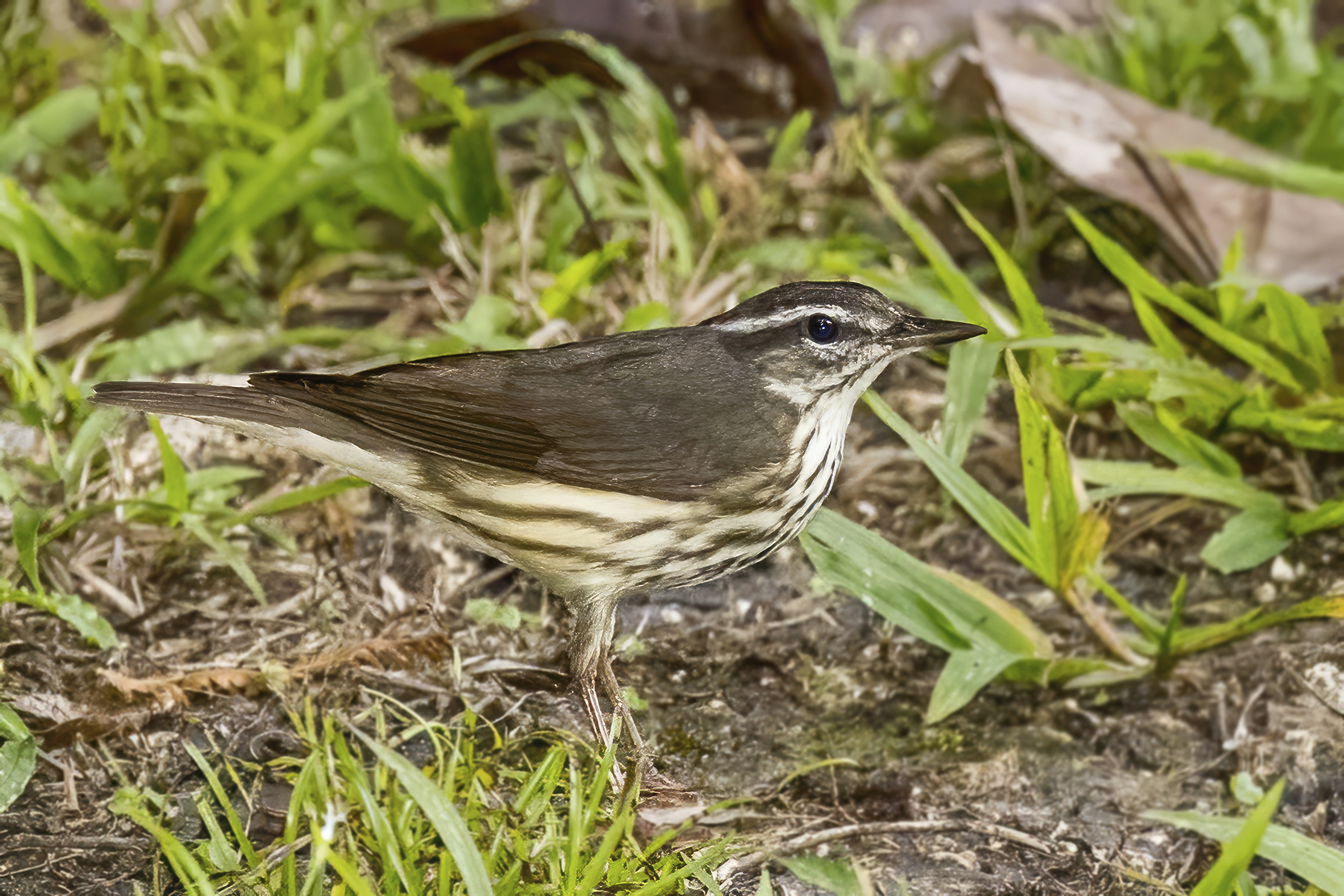
Louisiana Waterthrushes are a notable presence in approximately 7% of summer checklists. They are predominantly observed in Missouri from March to August.
In terms of appearance, Louisiana Waterthrushes may seem more subdued compared to other warblers. They display a brown coloration on their upper parts and have paler underparts. Notably, they possess a white eyebrow stripe and boast long pink legs.
Scientifically known as Parkesia motacilla, these waterthrushes measure around 5.9 to 6.1 inches (15-15.5 cm) in length and weigh approximately 0.6 to 0.8 ounces (18.2-22.9 g). Their wingspan spans from 9.4 to 10.6 inches (24-27 cm).
Louisiana Waterthrushes breed in eastern US states and can be observed in the southeastern region during migration. They spend their winter months in Mexico, Central America, and the Caribbean, returning early in the year during the spring.
You can encounter Louisiana Waterthrushes near streams and flowing water within woodlands, where they actively hunt for insects, vertebrates, and larvae.
Nests of Louisiana Waterthrushes are strategically positioned along the banks of streams, often hidden amidst roots or under logs. These nests are skillfully constructed using leaves, pine needles, and other plant materials, cleverly held together with mud.
29. Wood Thrush
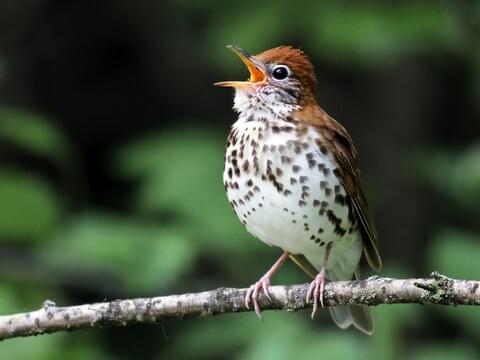
Wood Thrushes are primarily observed in Missouri during the breeding season, spanning from April to October, and they are documented in approximately 10% of checklists during this period.
Distinguished by their plump bodies and striking white bellies adorned with black spots, Wood Thrushes possess a slightly comical appearance. They showcase a brown hue on their backs, while their crown and upper back feature reddish colors.
Scientifically known as Hylocichla mustelina, Wood Thrushes measure around 7.5 to 8.3 inches (19-21 cm) in length and weigh approximately 1.4 to 1.8 ounces (40-50 g). Their wingspan spans from 11.8 to 13.4 inches (30-34 cm).
Wood Thrushes undertake an impressive migration journey, flying from eastern US states across the Gulf of Mexico into Central America in a single night.
These birds have a tendency to remain concealed as they forage in the leaf litter of mature forests, searching for insects such as beetles and flies. In the springtime, their melodious and flute-like songs can often be heard echoing through the woods.
30. Brown Creeper
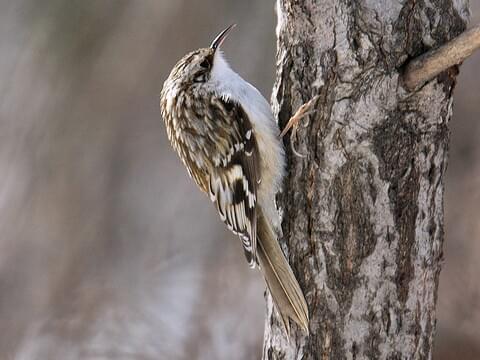
Brown Creepers are frequently observed in Missouri between October and April, appearing in approximately 5% of winter checklists.
These small songbirds can be challenging to spot against the backdrop of tree trunks due to their streaked brown backs and white undersides.
Scientifically known as Certhia americana, Brown Creepers measure around 4.7 to 5.5 inches (12-14 cm) in length, weigh approximately 0.2 to 0.3 ounces (5-10 g), and have a wingspan ranging from 6.7 to 7.9 inches (17-20 cm).
Unlike many migratory birds, Brown Creepers do not undertake long-distance migrations. However, they may move south or to lower elevations during the winter months. They can be found across a broad range, including Alaska, southern Canada, northeastern and eastern US states, extending down to Mexico and Central America. In certain winters, they may also venture into central and southeastern states.
To spot these tiny birds, carefully observe the tree trunks in mature woodlands with large trees, as this is where they are often found hunting for insects and larvae concealed beneath the bark.
One notable behavior of Brown Creepers is their unique method of climbing trees. Unlike nuthatches, which typically face down the tree trunk, Brown Creepers work their way up the tree, facing upwards.
Rather than singing, Brown Creepers emit a high-pitched and piercing call, which aids in locating them amidst their woodland habitat.
31. Pine Siskin
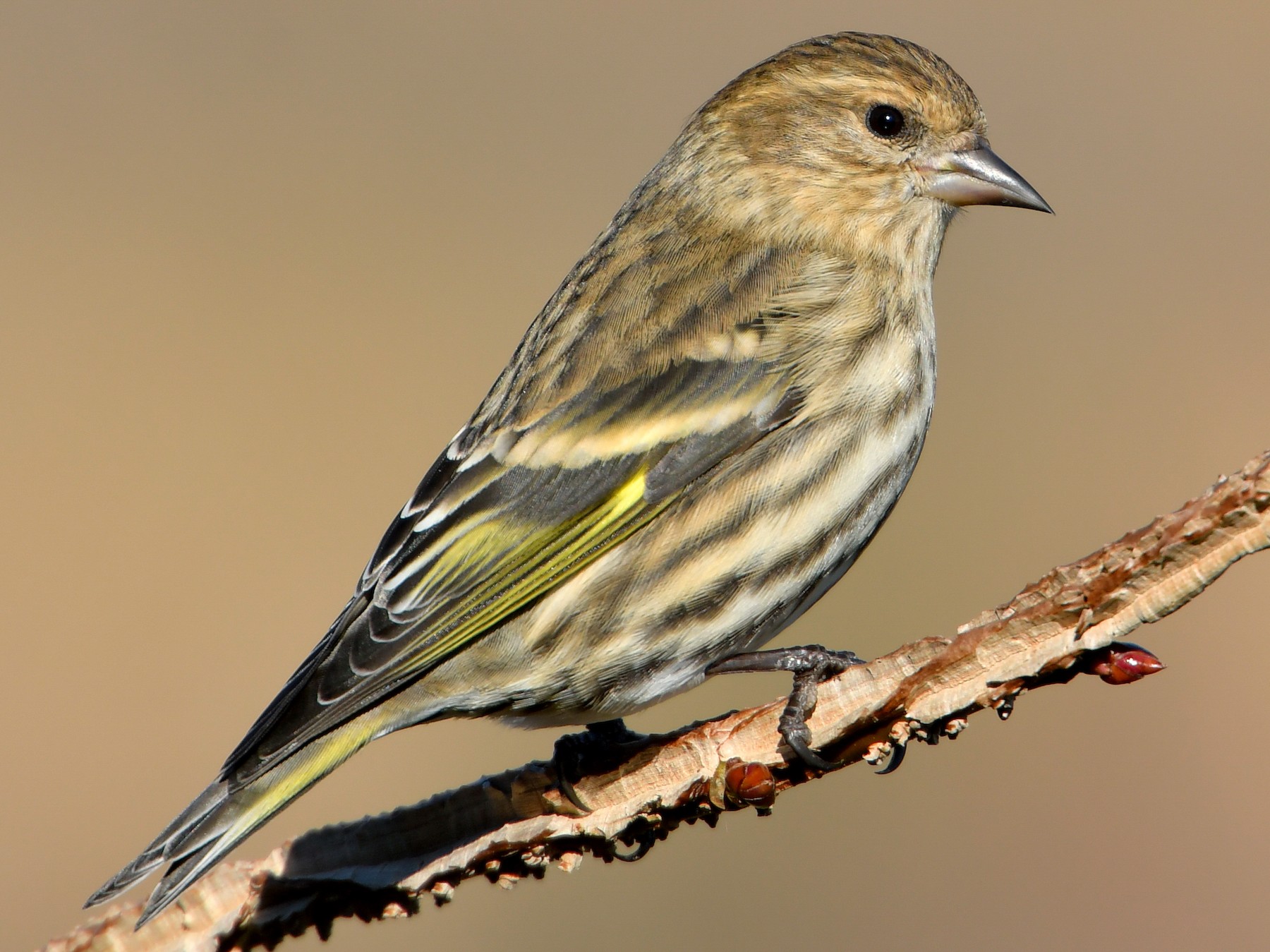
Pine Siskins are frequently observed migrating across Missouri, but some individuals also choose to overwinter in the southern regions of the state. They can be spotted between October and May, and they appear in approximately 3% of winter checklists.
These small brown finches exhibit distinct yellow streaks on their wings and tails. They possess forked tails, pointed wings, and short, pointed bills.
Scientifically known as Spinus pinus, Pine Siskins are typically residents of pine forests located in western states and along the Canadian border throughout the year. Some individuals also breed in Canada before embarking on their migration journey southward for the winter season.
The distribution of Pine Siskins across North America depends on the availability of pine cone crops. As their name suggests, they primarily feed on seeds from coniferous trees. However, they also consume young buds and seeds from grasses and weeds.
To attract Pine Siskins to your backyard, consider using thistle and nyjer feeders, as these seeds are particularly appealing to them. Additionally, they will also visit for black oil sunflower seeds and suet.
32. Hermit Thrush

During the winter season, Hermit Thrushes can be found in Missouri and are recorded in approximately 1% of checklists during this time. They are primarily observed between October and April.
Hermit Thrushes possess a distinctive appearance, standing upright with a chunky body and long tail. They exhibit brown plumage on their backs and white coloring underneath, adorned with spots on their throat and breast.
Scientifically known as Catharus guttatus, Hermit Thrushes breed in Canada, northeastern US states, and the western US. During migration, they can be spotted in central states before spending the winter along the Pacific Coast, southeastern states, and in Mexico.
When foraging, Hermit Thrushes primarily search the ground in forest clearings, sifting through the leaf litter in search of insects. In the winter season, they also consume berries.
While Hermit Thrushes are not frequent visitors to backyards, their somewhat melancholic song can be heard during the spring and summer months, adding a touch of nostalgia to their presence.
33. Winter Wren

Winter Wrens are commonly observed in Missouri during the winter season, accounting for approximately 2% of checklists during this time. They begin arriving in September, and while some may stay until July, the optimal months for spotting them are from October to April.
These small, plump birds exhibit brown plumage with darker barring on their wings, tail, and belly. They possess a paler eyebrow stripe and sport short tails, which they hold in an upright position. Notably, there is no visual distinction between males and females.
Winter Wrens bear a close resemblance to Pacific Wrens and were once considered the same species. However, they are now classified as separate species due to their distinct songs.
Scientifically known as Troglodytes hiemalis, Winter Wrens are present in eastern US states during winter and can be found in northeastern US states and Canada during the summer.
When searching for Winter Wrens, look amidst tangled undergrowth in forests and even backyards. They feed on insects and spiders, often rummaging through fallen leaves and decaying bark.
Nests of Winter Wrens are crafted using twigs, moss, and grass woven together into a round shape with a small opening. They typically lay 1 to 9 eggs, and the hatching process takes around two to two and a half weeks, followed by a similar duration for the fledglings to become independent.
To attract Winter Wrens to your backyard, consider incorporating native plants and ensuring dense vegetation, as these provide ideal conditions for their presence.
34. Northern Waterthrush

Northern Waterthrushes are commonly observed in Missouri from April to May and August to October. They appear in approximately 8% of checklists during the spring and 1% during the fall.
These birds resemble large thrushes, with both males and females displaying similar characteristics. They possess brown heads adorned with thick, white eyebrows, dark brown backs, and white bellies featuring heavy streaking from their throats to their rumps.
Scientifically known as Parkesia noveboracensis, Northern Waterthrushes breed in Canada, Alaska, and northeastern US states before embarking on their migration journey to Mexico, Central and South America, and the Caribbean. Some individuals may remain in Central and South America throughout the year.
You can typically find Northern Waterthrushes in dark, woody swamps, thickets, and bogs. They are often seen near still or sluggish water within forested areas. During the winter months in the tropics, they are commonly found among mangroves.
Northern Waterthrushes are skilled at both aquatic and terrestrial foraging. With their long legs, they can walk on shallow water as they search for prey such as water beetles, mosquitoes, slugs, crustaceans, snails, and occasionally, small fish. They also feed on caterpillars, moths, and ants, which they locate under leaves.
Nests of Northern Waterthrushes are typically situated in hollows or crevices near water sources. They may be found in a moss-covered stump or hidden under a protruding bank, but they are usually camouflaged among ferns.
35. Marsh Wren
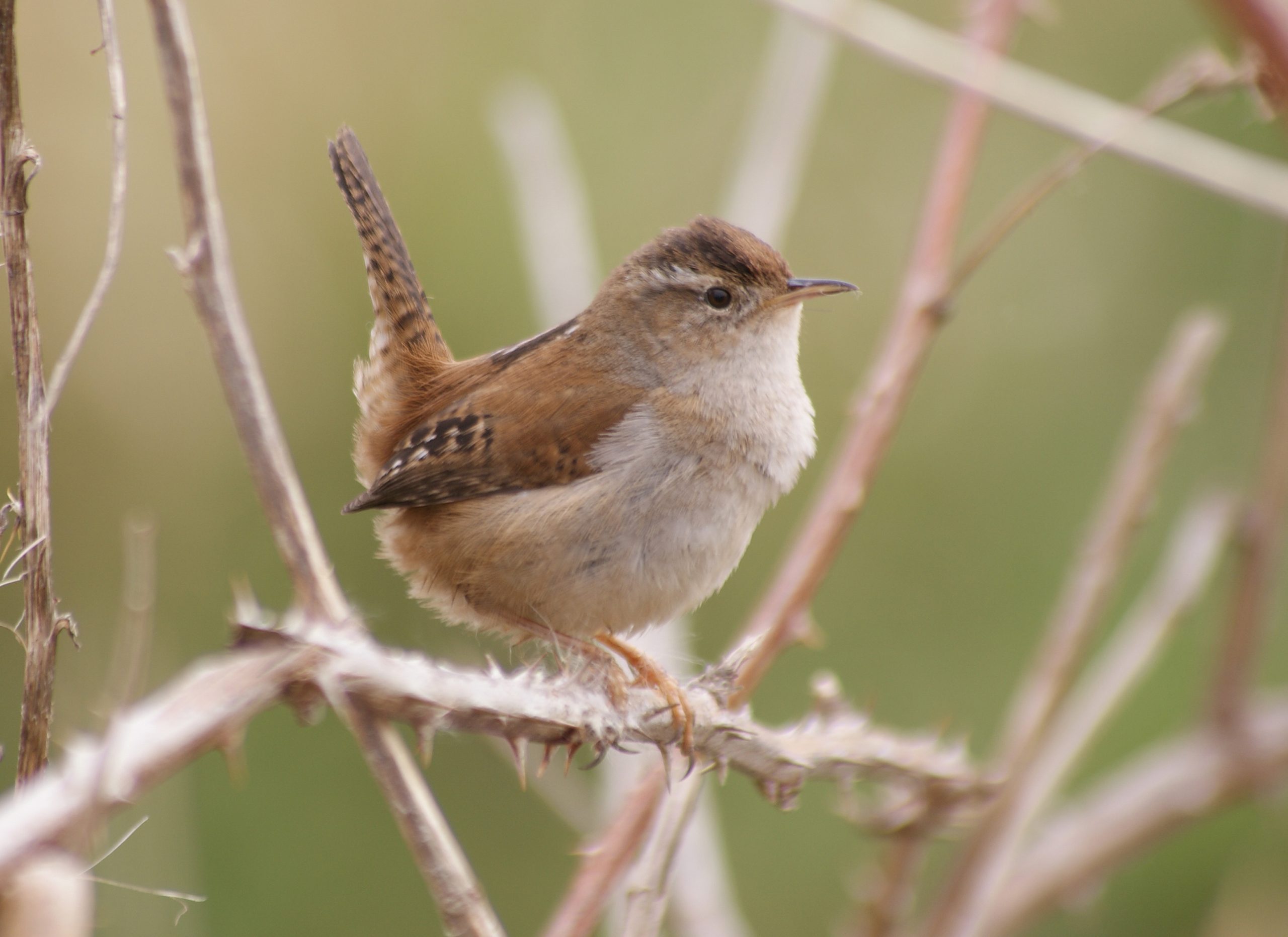
Marsh Wrens are primarily observed in Missouri during the spring and fall migration, particularly in April, May, September, and October. However, some individuals choose to reside in the region throughout the year.
These wrens display a brown plumage with distinctive black and white streaks on their backs. Their underside showcases a grayish-brown hue, and they possess the characteristic upright tail that is typical of wrens. Notably, there is no visual difference between males and females.
Marsh Wrens resemble other wren species but can be distinguished by the absence of stripes on their shoulders and their longer bills, particularly when compared to Sedge Wrens.
Scientifically known as Cistothorus palustris, Marsh Wrens breed in northern US states and central Canada before embarking on migration towards southern states and Mexico. Some individuals in the western regions and along the Atlantic Coast may remain resident throughout the year. They can be observed during migration in the eastern US.
When seeking Marsh Wrens, wetlands are their preferred habitat, where they cling to reeds by gripping each foot onto different stalks. Although they may be challenging to spot visually, listening for their distinctive singing among the reeds, especially at dawn and dusk, can aid in their detection. Marsh Wrens primarily feed on insects and spiders, which they pick off leaves in close proximity to the water.
Nests of Marsh Wrens are fully enclosed, except for a small opening at the top. They are constructed using woven reeds and grasses, providing a secure and cozy environment for nesting.
36. Bewick’s Wren
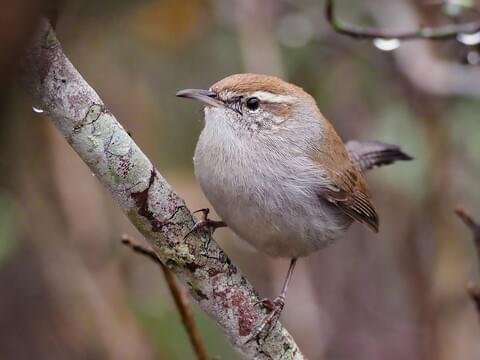
Bewick’s Wrens can be observed in Missouri during the breeding season, with their highest abundance occurring from April to July. However, a few individuals choose to reside in the region throughout the year.
These wrens display brown backs, complemented by long gray upright tails adorned with darker barring. They have gray bellies and a distinctive white stripe extending over the eye.
Scientifically known as Thryomanes bewickii, Bewick’s Wrens are year-round residents in southern and western states, with minor movements observed during winter.
To find Bewick’s Wrens, explore scrublands, thickets, and open woodlands, where they can be seen hopping from branch to branch, continually flicking their long tails. They primarily feed on insects and larvae, including bees, bugs, caterpillars, and beetles.
Nests of Bewick’s Wrens are situated on rock ledges, in old woodpecker nests, nest boxes, or crevices in buildings. They take on a cup-like shape and are constructed using sticks and grasses, with a softer lining for added comfort. The breeding pair typically lays 3 to 8 eggs, with an incubation period of around two weeks, followed by a further two weeks for the young to fledge.
To attract Bewick’s Wrens to your backyard, consider providing suet, mealworms, and hulled sunflower seeds as enticing food options.
37. Spotted Towhee
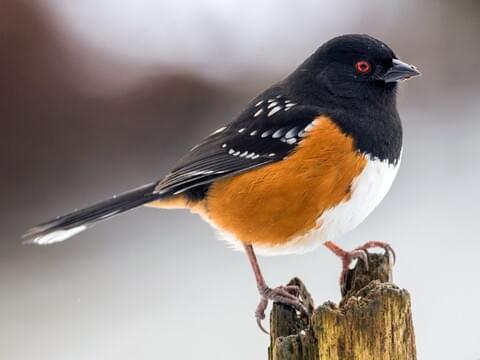
While Spotted Towhees are not commonly observed in Missouri, they are recognized as regular visitors to the area. They can be spotted in the western part of the state during migration, and a few individuals also choose to stay throughout the winter.
Spotted Towhees are sizable sparrows characterized by black plumage on the head, throat, and back in males, while females display brown coloring. Both males and females have reddish-brown sides and white bellies, adorned with white spots on their wings and back, along with long tails.
Scientifically known as Pipilo maculatus, Spotted Towhees primarily reside in western US states. However, those located inland in the northern regions migrate south to Texas after breeding.
When searching for food, Spotted Towhees can be found on the ground within dense shrub tangles, actively scratching around for insects such as beetles, crickets, grasshoppers, caterpillars, wasps, and bees. They also incorporate acorns, berries, and seeds into their diet.
Nests of Spotted Towhees are typically situated on or near the ground and constructed using leaves, stems, and bark, lined with softer materials. They lay up to six eggs, which require approximately two weeks to hatch, followed by a further ten days for the young to fledge.
To attract Spotted Towhees to your yard, consider maintaining overgrown borders, as they appreciate such habitat. They may visit platform feeders or ground feeders if provided with Black Oil Sunflower seeds, Hulled Sunflower seeds, Cracked Corn, Millet, and Milo as food options.
38. Golden-crowned Sparrow
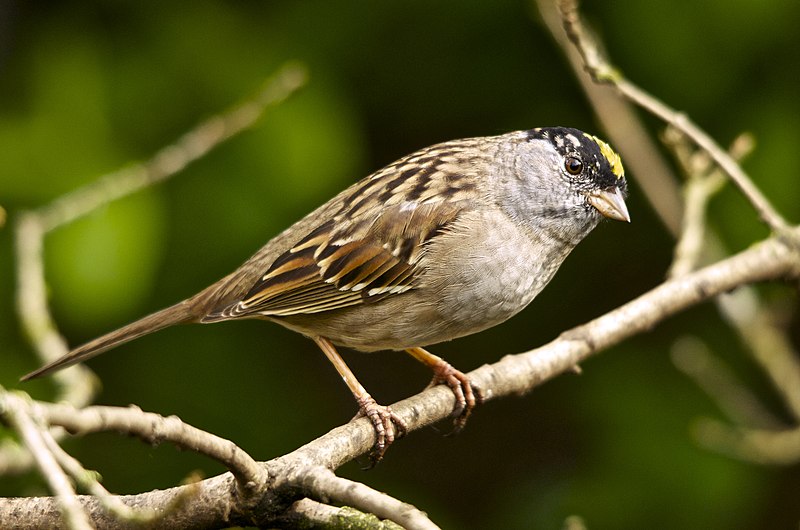
Golden-crowned Sparrows are exceptionally rare occurrences in Missouri, classified as accidental species within the state. The last sighting of this species was reported near Bunch Hollow Conservation Area in 2018.
These sparrows exhibit grayish-brown underparts and streaked brown plumage on their backs. Their heads feature a striking black crown and a vibrant yellow forehead.
During the winter season, their colors become duller, with the crown displaying a brownish hue, and the yellow forehead losing its vibrancy.
Scientifically known as Zonotrichia atricapilla, Golden-crowned Sparrows breed in Alaska and western Canada before embarking on migration towards the West Coast for the winter months.
When searching for these sparrows, you may come across them in weedy fields, diligently scratching the ground in search of seeds from plants such as dock, sumac, and geranium. They also incorporate fruits like apples, grapes, elderberries, and olives into their diet. Insects, including ants, beetles, butterflies, and termites, also contribute to their food sources.
Nests of Golden-crowned Sparrows are typically situated on the ground and constructed using twigs, moss, and leaves. They line the nests with softer materials like animal hair, grass, and feathers to create a cozy environment for their eggs.
Invite the presence of Golden-crowned Sparrows to your backyard by providing seeds on ground feeders or by cultivating native plants that bear fruits.
Checklists serve as a valuable tool for identifying the prevalent bird species within a particular state. By examining these lists, we can determine the frequency of brown bird sightings in Missouri during both the summer and winter seasons, as reported on eBird.
